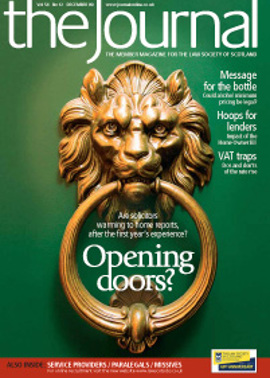Keeping the peace

Breach of the peace in private
There was always something odd about the decision in Young v Heatly 1959 JC 66. The idea that conduct, however reprehensible, which occurs in private and without affecting the community should give rise to a charge of breach of the peace, as opposed to some other crime, is not one which has ever sounded quite right. But the generations of Scottish criminal lawyers which have criticised the decision (but have had to live with it) can now rest easy: it has been overruled by a bench of five judges in Harris v HMA [2009] HCJAC 80 (opinion published 8 October 2009).
Whereas in Young the locus of the crime was a teacher’s private room at a technical school where the deputy headmaster made indecent suggestions to several of his pupils, in Harris the locus of the alleged breach of the peace was police headquarters in Dundee, where (according to the indictment held to be relevant by the sheriff) the accused had made threats to two police officers in the course of various conversations with them, which threats were said to have placed each of them in a state of fear and alarm. The accused appealed against the decision on relevancy, resulting in a full debate before the High Court of all the authorities, including the impact of ECHR.
Familiar cases such as Ferguson v Carnochan (1889) 16R (J) 93, Smith v Donnelly 2002 JC 65 and Jones v Carnegie 2004 JC 136 were all analysed again, the court confirming that a conjunctive test was required: there had to be conduct which presented as genuinely alarming in its context to any reasonable person and which threatened serious disturbance to the community. That was not what had happened in the teacher’s room in Young v Heatly, a decision which was found to be erroneous in a number of important respects, particularly because of the absence of a public element to what had occurred: there was nothing which produced or was likely to produce alarm in the minds of the lieges. Nor did the conduct complained of in the instant case have this vital element; it was not suggested that any of the officers involved might have been provoked to react by taking the law into his own hands or that otherwise there could have been any apprehension of a disturbance to the public peace.
But the court declined to provide definitive guidance as to what public element would be sufficient to transform private conduct into a breach of the peace, observing that disturbance or potential disturbance of even a small group of individuals in a private house might suffice, provided there was a realistic risk of it being discovered. The appeal was allowed and the sheriff directed to dismiss the charges as irrelevant.
Voice samples at ID parades
It has long been the practice in Scotland that a person participating in an identification parade can be asked to speak, so that what he says and how he says it can be compared by a witness at the parade to the voice of the person he heard at the material time of the crime. Further, if the solicitor attending the parade on behalf of the suspect is concerned that the parade is in any way unfair, he should make his objection known at the time; and likewise if at the later trial the evidence of what happened at the parade is thought to be objectionable, it should be made the subject of objection when it is led. In terms of s 118(8) of the 1995 Act, failure by the defence representative to object timeously will bar a successful appeal.
In McFadden v HMA [2009] HCJAC 78 (8 October 2009), no objection was taken during the trial to the leading of evidence of voice identification, a decision characterised by the appeal court as a proper exercise of professional judgment by trial counsel and giving no rise to Anderson criticism. In so doing, the court rejected an ECHR ground of appeal to the effect that the accepted Scottish practice of requiring voice samples was contrary to article
6 and could be characterised as a breach of the right to silence or the right not to incriminate oneself. Domestic case law had sought to find the correct balance between the public interest and the interests of the accused and to address the issue of proportionality; in the circumstances of the present case, there had been a fair trial and the appeal was refused.
Discounting disqualification
One of the yet-unanswered problems thrown up by the system of sentence discounting is whether in a road traffic case the ancillary elements of the sentence should be discounted. What about the length of the disqualification and/or the number of penalty points? Should any discount be applied to either or both if and when the offender pleads guilty? There has been no consistent approach taken in the sheriff court, but this may change once the appeal court has considered the remitted appeal in Ross v PF Aberdeen [2009] HCJAC 82 (22 October 2009).
The appellant had pleaded guilty by letter to a contravention of s 3 of the Road Traffic Act 1988. His fine was discounted by one third, but no discount was applied to the number of penalty points imposed, in line with Stewart v Griffiths 2005 SCCR 291. He appealed against this decision, citing the emerging practice of discounting periods of disqualification, on the basis that one component of the latter might be punishment (see Rennie v Frame 2005 SCCR 608) and that the same might be said for penalty points. In order that there might be definitive guidelines on the sentencing issues thus raised, the case was remitted to a bench of five judges.
Evidence on commission
The possibility of taking evidence on commission in a criminal case was first introduced in Scotland in 1980 and is now to be found in s 272 of the 1995 Act. Applications to take evidence in that way have been rarely encountered, but five were recently granted by Lord Brodie in HMA v RM [2009] HCJ 05 (28 October 2009).
As might be expected, the cases were fact-specific: the petitions were in presented by the Crown with a view to taking evidence from five elderly complainers who were housebound and unable to come to give evidence in court. It was alleged that each had been the victim of a fraud perpetrated after the accused had obtained entry to their homes. What was proposed was an open commission with the trial judge as commissioner attending at the home of each complainer, along with counsel and solicitors on both sides, a shorthand writer and clerk of court, but not the accused.
Lord Brodie rejected objections based on s 272(3)(a) and (b) of the 1995 Act, holding that the evidence was necessary for the proper adjudication of the trial and that there would be no unfairness to the accused in the proposed procedure. Although the latter would not be present when the witnesses were examined, he would see the transcript of their evidence before it was read out in court. In the unlikely and exceptional event that the cross examination previously conducted had been less than complete, it would be possible to take further evidence from the witness. In addition, modern practice was much more familiar with provisions (such as those introduced by the Vulnerable Witnesses (Scotland) Act 2004) designed to facilitate the giving of evidence by more or less indirect means.
And finally?
In the August issue I commented on the decision in McIntyre v HMA (now reported at 2009 SCCR 719),
in which the High Court held, founding on s 124 of the 1995 Act, that once an appeal against conviction has been determined, the appeal cannot be reopened in such a way as to allow consideration of a further purported ground of appeal against conviction, apart of course from the situation where the case is referred to the court by the Scottish Criminal Cases Review Commission. But in Harris, Petr [2009] HCJAC 85 (opinion published 27 October 2009), following a decision by the Commission not to make such a reference in respect of an appeal against conviction which had been refused in 2006, a petition to the nobile officium was presented. There, the petitioner sought to reopen by that means the 2006 conviction, arguing simply that McInytre was “wrong”.
Not surprisingly, this submission was emphatically rejected by the High Court, since no attempt was made to distinguish that decision, or the earlier case of Cochrane, Petr, 2006 SCCR 213. The petition was dismissed as incompetent. It was
held that s 124 had been properly interpreted in McIntyre; it was not (as the petitioner contended) concerned only with the prevention of appeals to the House of Lords. The principle of stare decisis applied, and the petitioner had exhausted his rights under the statutory scheme.
However, that may still not be the end of this saga, for a bench of five judges is expected to rule soon in a number of further similar petitions by convicted persons, including Nat Fraser and Luke Mitchell. As they say, watch this space.
Charles Stoddart is a criminal law author and a former sheriff
In this issue
- Home reports have devastated the Scottish house market
- Review of the Fatal Accident Inquiry Legislation
- The Gill Review: a personal injury practitioner’s perspective
- A tale for our times
- A step too far?
- Report card
- Down the slipway
- Homing instinct
- Bottle for a contest
- Ready for the VAT rise?
- New website to promote training openings
- First solicitor advocates approved as "senior"
- Your feedback
- The very definition of paralegal
- Law reform update
- Lawyers can network too
- Ask Ash
- Welcome, user! (and you're sued)
- Communication, communication, communication
- Keeping the peace
- On the mark?
- Crown disclosure: the next level
- Tackling improvements
- Camera angles
- Cutting red tape in Europe
- Scottish Solicitors' Discipline Tribunal
- Website review
- Book reviews
- Calling the shots
- Sector "rising to challenge": Millar
- "One size" is a dodgy fit
- BSA brings in standard instructions
- A new burden is born






